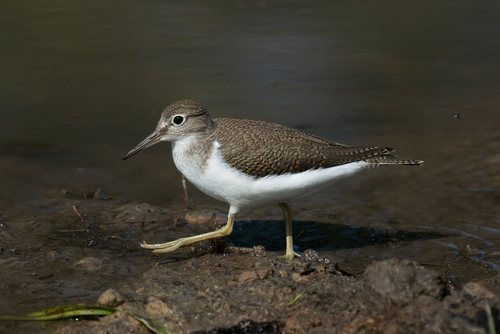
Common Sandpiper
The Common Sandpiper (*Actitis hypoleucos*) is a small, widespread shorebird known for its distinctive bobbing motion and its preference for freshwater habitats. It plays a crucial role in wetland ecosystems by controlling insect populations and serving as prey for larger predators. While not possessing particularly striking plumage, its constant teetering and widespread distribution make it a familiar sight across much of the Old World. It holds no specific, widely recognized cultural significance, but its ubiquity makes it a common subject of observation for birdwatchers.
18-20 cm
Length
32-35 cm
Wingspan
Least Concern
Conservation Status
Distribution
Breeds across most of Europe and Asia, and winters in Africa, southern Asia, and Australasia. Migratory routes follow coastlines and major river systems. Altitudinal range extends from sea level to mountainous regions, up to 4,000 meters in some areas.
Lifespan
Average lifespan in the wild is around 8 years, but individuals have been recorded living up to 12 years.
Common Sandpiper's Habitat
Habitat Types
Riverbanks, Lake shores, Reservoirs, Streams, Coastal wetlands, Estuaries
Climate Zones
Temperate, Boreal, Subtropical, Tropical
Adaptations
Their preference for freshwater habitats is notable, though they can tolerate brackish conditions. Their relatively short legs are adapted for wading in shallow water and foraging along shorelines.
Variations
No widely recognized subspecies are currently identified, although slight regional variations in size and plumage tone have been observed.
Appearance
Breeding Plumage
Breeding plumage features more distinct brown barring on the upperparts and a clearer white breast. Non-breeding plumage is duller, with less pronounced markings.
Seasonal Feather Changes
Plumage changes occur primarily between breeding and non-breeding seasons, with molting taking place before and after migration.
Sex Based Plumage Differences
Males and females have very similar plumage, making visual distinction difficult.
Notable Features
Characteristic bobbing or 'teetering' motion of the tail and body., White 'shoulder' mark extending up from the breast., Brown upperparts and white underparts.
Diet and Feeding
Primary Foods
Insects, Crustaceans, Mollusks, Small invertebrates, Spiders
Foraging Behavior
Forages actively along shorelines, picking prey from the surface or probing in mud and shallow water. Often seen running short distances and then abruptly stopping to peck at prey.
Specializations
No highly specialized feeding adaptations; a generalist feeder within its preferred habitat.
Seasonal Diet Variations
Diet shifts slightly depending on prey availability. During breeding season, insects are more prevalent, while crustaceans and mollusks may be more important during winter.
Behavior
Social Structure
Generally solitary or found in pairs during the breeding season. May form small, loose flocks during migration and in wintering areas.
Communication
High-pitched 'twee-wee-wee' call, often given in flight., Alarm calls are sharper and more insistent., Visual displays, including the characteristic bobbing.
Migration
Long-distance migrant, with some populations traveling thousands of kilometers between breeding and wintering grounds. Migrates both day and night.
Territorial or Group Behaviors
Territorial during the breeding season, defending the area around the nest. Not strongly territorial outside of the breeding season.
Conservation
Threats
Habitat loss and degradation (due to drainage, pollution, and development), Climate change (affecting breeding and wintering habitats), Disturbance from human activities
Protection Programs
International agreements like the African-Eurasian Migratory Waterbird Agreement (AEWA), Habitat protection and restoration efforts in some areas
Local National Laws
Protected under various national and international wildlife legislation, such as the Migratory Bird Treaty Act in the US (although not applicable as it's not found in the US) and similar laws in Europe and Asia.
Population Trend
Stable
Population Estimates
Global population estimated to be between 2,600,000 and 3,200,000 individuals.
Interesting Facts
They are known for their constant bobbing motion.
This behavior, called 'teetering,' is thought to help them spot prey or perhaps confuse predators.
They are one of the most widespread sandpipers.
Their extensive breeding and wintering ranges cover a significant portion of the Old World.
They can swim and dive if necessary.
Although primarily waders, they are capable swimmers and will dive to escape predators.
Faqs about Common Sandpiper
What is the purpose of the Common Sandpiper's bobbing?
The exact reason is not fully understood, but it may help with prey detection, predator avoidance, or communication.
Where can I see a Common Sandpiper?
Look for them near freshwater habitats, such as rivers, lakes, and streams, during their breeding season or along migration routes and wintering grounds.
Are Common Sandpipers endangered?
No, they are classified as 'Least Concern' by the IUCN due to their large population and wide distribution.
Copyright @ Nature Style Limited. All Rights Reserved.
 English
English